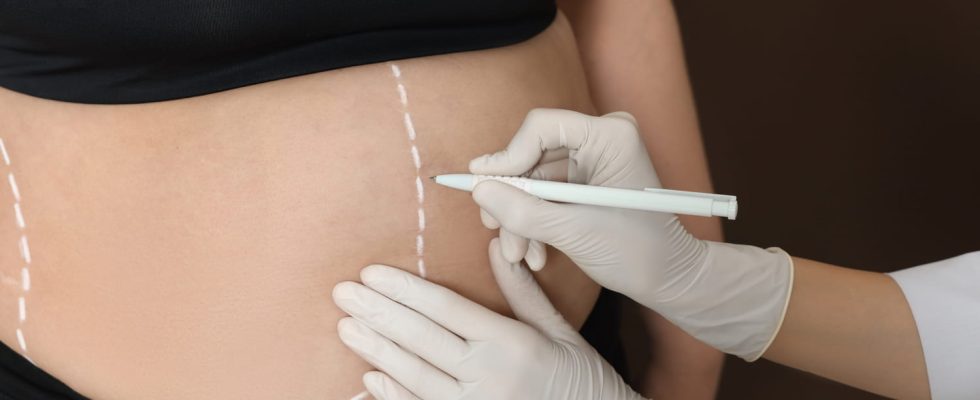Sleeve gastrectomy is a surgical operation intended for people with obesity. It is a different technique from gastric bypass.
More than 60,000 people have surgery every year in France to treat their obesity. There sleeve or “sleeve gastrectomy” is an operation that is part of so-called “bariatric” surgery intended for the management of obesity. The objective of the sleeve is to reduce stomach volume. She is not without complications. Patient follow-up, particularly within Specialized Obesity Centers (CSO), is very important after a sleeve.
Definition: what is the sleeve?
Performed for the first time in 2001, sleeve gastrectomy is a digestive surgical procedure performed on morbidly obese patients. This operation consists of remove about two-thirds of the stomach. This technique removes the part containing the cells that secrete the appetite-stimulating hormone, ghrelin, thus causing an disinterest in food. The stomach is reduced to a vertical tube and food passes quickly through the intestine. There weight loss is approximately 25 to 35 kg. This technique does not disrupt the digestion of food because they are first slowed down as they pass through the tube, then evacuated very quickly into the intestine.
BMI calculation to do the sleeve
Obesity surgery concerns adults who are significantly overweight, that is to say, those with significant obesity. To qualify for the sleeve, you must have a BMI greater than or equal to 40 kg/m² or one BMI greater than or equal to 35 kg/m² with at least one comorbidity likely to be improved after surgery (hypertension, sleep apnea syndrome, type 2 diabetes, disabling osteoarticular diseases, non-alcoholic steatohepatitis for example).
For who ?
The sleeve is a technique reserved for people:
- therefore having a BMI greater than 40kg/m² or greater than 35 kg/² associated with at least one complication.
- aged 18 to 60 years old.
- having no psychological contraindication.
- not presenting any specific surgical risk.
It is only offered after other weight loss methods have failed (dietary monitoring, physical activity, etc.).
The sleeve is an intervention prepared several months in advance. It requires interviews with the surgeon, the anesthesiologist, a psychologist and a dietician. Meetings with people who have already benefited from this technique are also offered. Preparing for the mode ofdiet “after the operation” must be done in advance. It is only at the end of this preparation that the medical team will decide if the intervention can take place or if it must be postponed or canceled.
In practice : the operation is generally carried out under laparoscopy and general anesthesia. The duration of thehospitalization varies from 2 to 10 days depending on the type of intervention and the general condition of the person. It can be extended if complications arise after the procedure. You must plan for at least 2 weeks of sick leave after leaving the hospital. Like any procedure on the abdomen, the aftermath of the operation can be painful.
After the operation
Long-term follow-up is essential and it is sometimes necessary to perform a second surgical procedure. In addition, it is important to know that this intervention is irreversible. After the operation:
- ingest small amounts with each meal and chew slowly
- eat your meals seated and in peace
- stop eating as soon as you have the first digestive pulls and as soon as you no longer feel hungry (satiety)
- do not drink while eating (but enough between meals)
- eat a balanced and varied diet to avoid nutritional deficiencies and increase your chances of losing weight
- maintain a sufficient protein intake (meat, fish, eggs, dairy products)
- avoid carbonated drinks, sugary drinks, sauces and fried foods, as well as sweets and fatty foods.
Complications
Sleeve complications are rare but can occur.
- THE risk of post-operative fistula is one of the main risks of this intervention. Performing a TOGD, esophagogastric transit between the first and third postoperative day and before resuming eating is necessary in order to detect a fistula.
- Other complications may appear in the days following the operation such as perforation or hemorrhage.
- Gastroesophageal reflux, inflammation of the esophagus, or enlargement of the stomach may also occur.
- An infection in a scar may appear in the few weeks following the operation.
- Nutritional deficiencies that can cause anemia, gastric ulcer, or tube stenosis may also occur.
Mortality rate
“The rate of early mortality East very weak“ concerning bariatric surgery (sleeve/bypass), informed theAP-HP in 2019. With teams from Cnam, Brest University Hospital and the University of Paris and Sorbonne University, the AP-HP evaluated, over 7 years, the complications of different bariatric surgery techniques. THE results showed that long-term mortality was lower in the group of obese patients who had undergone bariatric surgery than in the control group of non-operated obese patients. However, the operated patients had a doubled risk of complications leading to a new intervention digestive surgery (occlusion, hemorrhagic or perforated ulcer, parietal hernias…). They also had a risk multiplied by 2 to 5 nutritional deficiencies requiring hospitalization.
